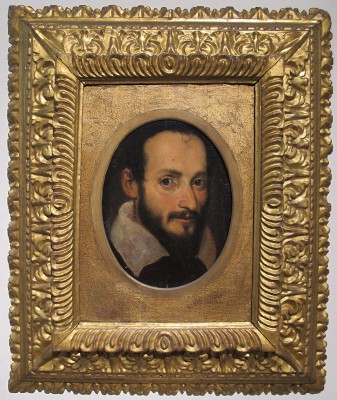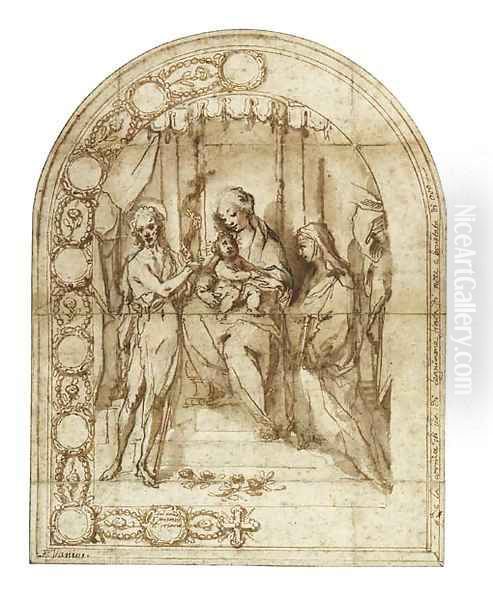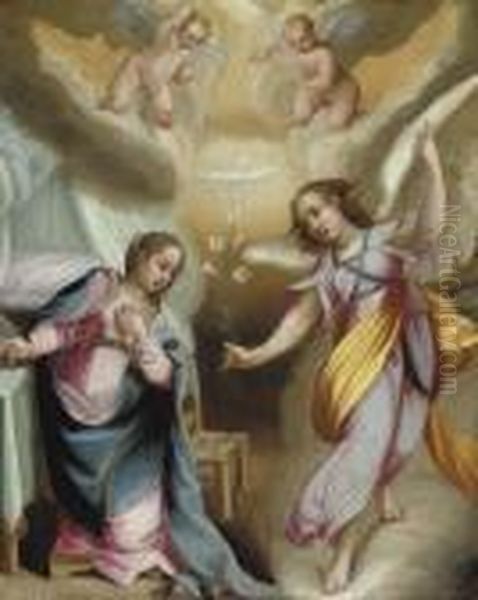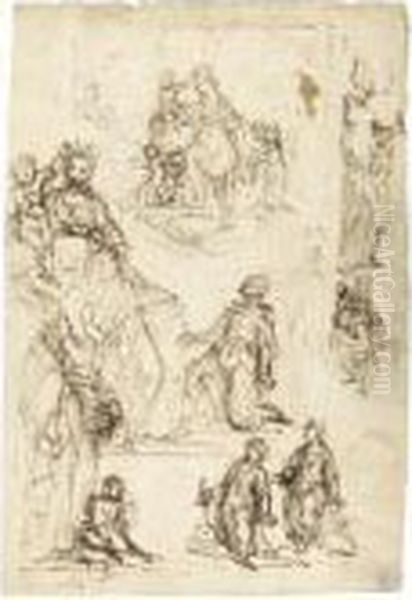
Francesco Vanni (1563–1610) stands as one of the most significant painters hailing from Siena during the late 16th and early 17th centuries. Active primarily in his native Siena and also in Rome, Vanni navigated the complex artistic currents of his time, skillfully blending the rich traditions of Sienese art with the innovations emerging from Rome and the influential style of Federico Barocci. His work, predominantly focused on religious themes, resonated deeply with the spiritual intensity of the Counter-Reformation, establishing him as a leading figure in the transition from late Mannerism to the early Baroque.
Vanni's artistic journey began in Siena, a city with a proud and distinct artistic heritage. Born into a family connected to the arts, his initial training likely occurred under his uncle, Arcangelo Salimbeni, a respected Sienese painter. This early exposure grounded him in the local traditions characterized by elegant lines and decorative sensibilities, tracing back to masters like Duccio and Simone Martini, and more recently, Domenico Beccafumi.
Early Life and Artistic Formation
To further his education and broaden his horizons, the young Vanni traveled to Rome. This move proved pivotal in his development. In the bustling artistic center of papal Rome, he studied with Giovanni de' Vecchi, a painter involved in significant decorative projects. More importantly, Rome exposed Vanni to a vast array of artistic stimuli, from the monumental works of High Renaissance masters like Raphael and Michelangelo to the contemporary trends shaping late 16th-century art.
During his time in Rome, Vanni encountered the work of various artists, including Girolamo Muziano and potentially Raffaelino da Reggio. However, the most profound impact came from the art of Federico Barocci, the Urbino-born painter whose sensitive handling of color, light, and emotion offered a compelling alternative to the prevailing Mannerist styles. Vanni deeply absorbed Barocci's approach, particularly his use of soft, sfumato-like modeling, vibrant, often pastel-like colors, and his ability to convey genuine piety and tenderness.

Vanni adopted Barocci's working methods, including the practice of creating preparatory sketches in oil on paper, which allowed for greater fluidity and exploration of color and light effects before committing to the final canvas or panel. This influence became a defining characteristic of Vanni's mature style, setting him apart within the Sienese school upon his return.
The Development of a Distinctive Style
Returning to Siena, Francesco Vanni synthesized his diverse experiences into a unique and highly appealing artistic language. His style gracefully combined the linear elegance and devotional sincerity of Sienese tradition with the compositional solidity learned in Rome and the chromatic richness and emotional warmth derived from Barocci. He became exceptionally skilled at depicting moments of intense religious feeling – ecstasies, visions, and scenes of maternal tenderness – making his work highly sought after for altarpieces and private devotional paintings.
Vanni's paintings are characterized by their refined execution, delicate modeling of figures, and a sophisticated use of color and light. While influenced by Barocci's palette, Vanni often employed a slightly more robust color scheme, maintaining clarity and narrative force. His command of disegno (drawing and design) remained strong, evident in the clear articulation of forms and compositions, yet it was often softened by his painterly handling of light, which created gentle transitions and a palpable atmosphere. His approach can be seen as a Sienese interpretation of the broader artistic reforms occurring in Italy, which sought greater naturalism and direct emotional engagement compared to the artificiality of high Mannerism.
Major Religious Commissions in Siena
Vanni quickly established himself as the leading painter in Siena, securing numerous important commissions for the city's churches. One notable early work is the Baptism of Christ, painted in 1586 for the Church of San Agostino. This piece already demonstrates his ability to handle complex multi-figure compositions and imbue a sacred event with both solemnity and grace.
Another significant Sienese commission was the Mystic Marriage of Saint Catherine for the Basilica of San Domenico, completed around 1601. Saint Catherine of Siena being one of the city's patron saints, this theme held particular resonance. Vanni depicted the subject with characteristic sensitivity, focusing on the intimate and divine nature of the vision experienced by the saint, rendered with delicate figures and luminous color.

His prominence in Siena is further attested by works like Saint Hyacinth Resuscitating a Drowned Child. This painting showcases Vanni's narrative skill, capturing the drama and miraculous intervention with clarity and emotional impact. The depiction of the saint, aided by angels, performing the miracle is rendered with a combination of realism in the figures and a divine light that underscores the supernatural event.
Vanni also painted numerous depictions of the Madonna and Child, including variations on the theme of the Immaculate Conception. These works often highlight his ability to convey the purity and tenderness of the Virgin Mary, frequently set against softly lit backgrounds or celestial settings, emphasizing the sacred atmosphere. His success in Siena cemented his reputation and led to commissions from beyond the city walls.
Activity in Rome and Papal Patronage
Francesco Vanni's reputation extended back to Rome, where he also received significant commissions. He painted a Pietà (Lamentation over the Dead Christ) for the Church of Santa Maria in Vallicella, also known as the Chiesa Nuova. This church was the mother church of the Oratorians, a religious order founded by Saint Philip Neri, which played a crucial role in the Counter-Reformation. Vanni's ability to convey deep pathos and piety made his work suitable for such important centers of religious renewal.
Perhaps the most prestigious commission Vanni received was for an altarpiece destined for St. Peter's Basilica in the Vatican. He painted The Reprimand of Saint Cyprian (sometimes identified as The Fall of Simon Magus), a subject intended for one of the basilica's altars. Receiving a commission for the principal church of Christendom was a mark of high honor and recognition, placing Vanni among the select group of artists entrusted with decorating this sacred space during a period of intense artistic activity under papal patronage. This commission underscored his standing not just in Siena, but on the larger Italian stage.
Mastery in Drawing and Printmaking
Beyond his achievements as a painter, Francesco Vanni was a prolific and highly accomplished draftsman. A large number of his drawings survive, executed in various techniques including black and red chalk, pen and ink, and wash. These drawings reveal his working process, from initial compositional sketches to detailed studies of figures and drapery. His drawing style is often characterized by its fluency, elegance, and sensitivity to light and form.

His skill as a draftsman was widely recognized during his lifetime. His drawings were compared favorably to those of earlier Sienese masters like Domenico Beccafumi, known for his innovative and expressive graphic work. Vanni's drawings were highly sought after by collectors. Notably, Cardinal Leopoldo de' Medici, a member of the powerful Florentine family and a discerning art collector, expressed great admiration for Vanni's drawings and commissioned examples for his own collection, a testament to the artist's esteemed reputation in this field.
Surviving drawings like the Study for a Right Hand demonstrate his careful observation of anatomy and his ability to imbue even fragmentary studies with a sense of life and potential expression. Works like the Virgin Adoring the Sleeping Child, now housed in the Rijksmuseum in Amsterdam, exemplify the tenderness and devotional intimacy he could achieve through line and wash.
Vanni also engaged with printmaking, primarily etching. He translated some of his own compositions into prints, such as the Stigmatization of Saint Catherine. These prints served to disseminate his artistic ideas more widely, reaching a broader audience beyond those who could see his paintings in churches or private collections. His activity in this medium further highlights his versatility and his engagement with the artistic technologies of his time.
Collaboration and Sienese Dominance
Francesco Vanni's artistic activity in Siena was closely intertwined with that of his half-brother, Ventura Salimbeni (1568–1613). Ventura was also a talented painter, trained initially by their uncle Arcangelo Salimbeni. While sharing a similar artistic grounding and often working in a comparable style influenced by Roman and Baroccesque trends, subtle differences exist, with Francesco often considered the more refined colorist and perhaps more emotionally nuanced.
Together, Francesco Vanni and Ventura Salimbeni effectively dominated the artistic landscape of Siena in the late 16th and early 17th centuries. They received the lion's share of important commissions for altarpieces and frescoes in the city and its surrounding territory. Their workshops were highly productive, and their combined influence shaped the direction of Sienese painting during this period, moving it decisively away from older Mannerist conventions towards a more accessible, emotionally direct, and coloristically rich early Baroque style.
Vanni in the Context of His Time
Francesco Vanni worked during a period of significant transition in Italian art. The Council of Trent had concluded in 1563, the year of his birth, and its decrees promoting clarity, decorum, and emotional engagement in religious art profoundly shaped the artistic production of the late 16th and early 17th centuries. Vanni's art, with its blend of elegance, naturalism, and pious sentiment, perfectly aligned with these Counter-Reformation objectives.
His style can be situated amidst several key artistic developments. His debt to Federico Barocci is clear and fundamental. He also operated concurrently with the Carracci reform movement based in Bologna, led by Annibale Carracci, Agostino Carracci, and Ludovico Carracci. While Vanni likely knew of their work, particularly Annibale's activity in Rome, his style retained a distinct character, less focused on classical structure and heroic forms than the Carracci, and more attuned to the softer, more lyrical qualities inherited from Barocci and Sienese tradition.
In Rome, Vanni would have been aware of the revolutionary naturalism and dramatic chiaroscuro of Michelangelo Merisi da Caravaggio. While both artists aimed for a more direct and emotionally compelling religious art, their approaches differed significantly. Vanni's work generally avoided the stark realism and intense, often violent, drama found in Caravaggio, favoring instead a more idealized beauty and a gentler, more luminous handling of light. His contemporaries also included Florentine reformers like Ludovico Cardi (known as Cigoli) and Domenico Passignano, who were similarly navigating the path from Mannerism towards Baroque clarity and expressiveness. His interactions with figures like Giovanni de' Vecchi and Girolamo Muziano during his formative years in Rome also place him within the network of established artists working on major papal and ecclesiastical projects.
Legacy and Scholarly Attention
Francesco Vanni died in Siena in 1610, at the height of his career. He left a significant legacy as the most important Sienese painter of his generation. His influence extended beyond Siena to other centers in Tuscany, including Pistoia, Cortona, and Pisa, where he also executed commissions. He successfully updated the Sienese tradition, infusing it with contemporary Roman and Baroccesque elements, thereby ensuring its vitality into the 17th century.
His works are preserved today in numerous churches in Siena and Rome, as well as in major museums worldwide, including the Uffizi Gallery in Florence, the Louvre Museum in Paris, the Kupferstichkabinett in Berlin, and the Rijksmuseum in Amsterdam. The substantial corpus of surviving paintings and drawings allows for a comprehensive understanding of his artistic output and development.
Modern art historical scholarship continues to explore various facets of Vanni's career. Studies have focused on his patrons, his working methods (particularly his use of preparatory sketches), his relationship with printmakers, and the iconography of his works. For instance, analyses of altarpieces like the Ecstasy of Saint Francis delve into the specific theological and devotional contexts of his imagery. Books and articles, such as those examining late Renaissance art in Siena, consistently recognize Vanni's pivotal role and artistic quality, confirming his status as a key figure bridging the late Renaissance and the Baroque in central Italy.
Conclusion
Francesco Vanni remains a compelling figure in Italian art history. As a painter, draftsman, and etcher, he demonstrated exceptional skill and sensitivity. He adeptly synthesized the artistic currents of his time – the elegance of his native Sienese tradition, the compositional lessons of Rome, and the vibrant color and emotion of Federico Barocci – to forge a distinctive and influential style. His work, deeply imbued with the religious spirit of the Counter-Reformation, resonated with patrons and worshippers alike through its clarity, beauty, and heartfelt piety. Francesco Vanni stands as a testament to the enduring creativity of the Sienese school and as a crucial contributor to the development of early Baroque painting in Italy.